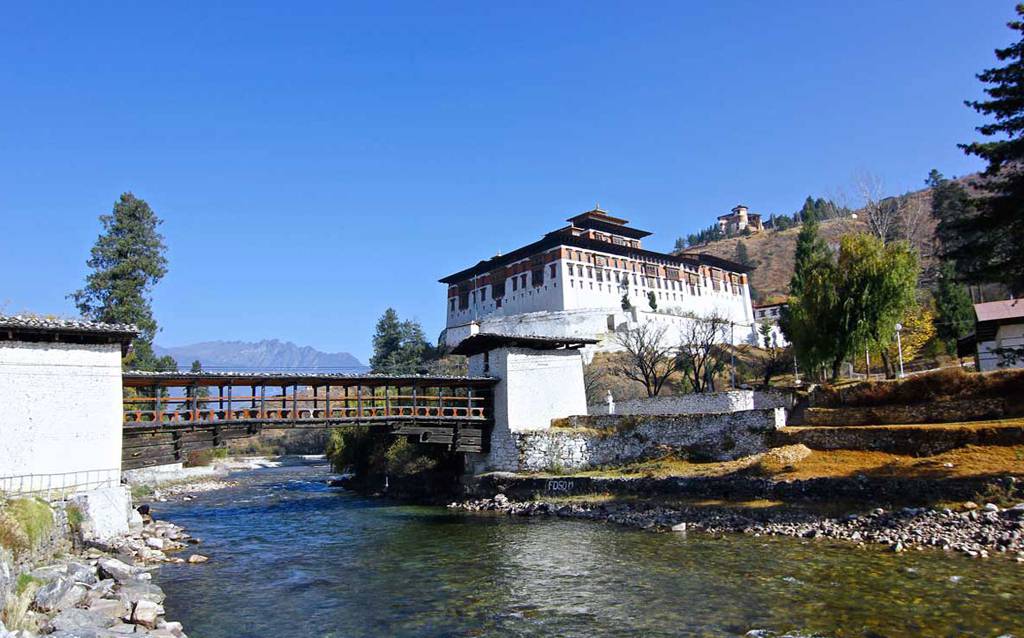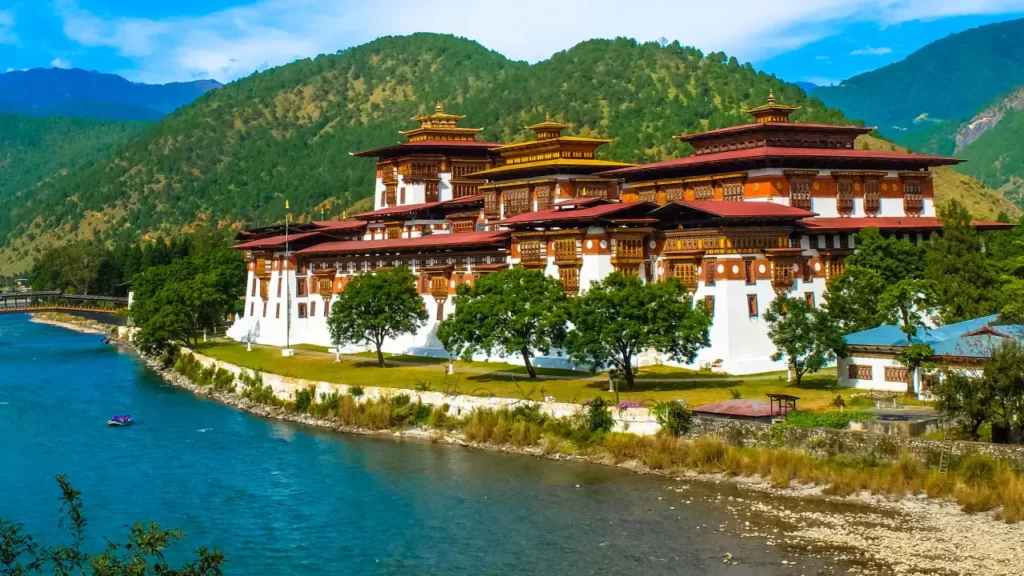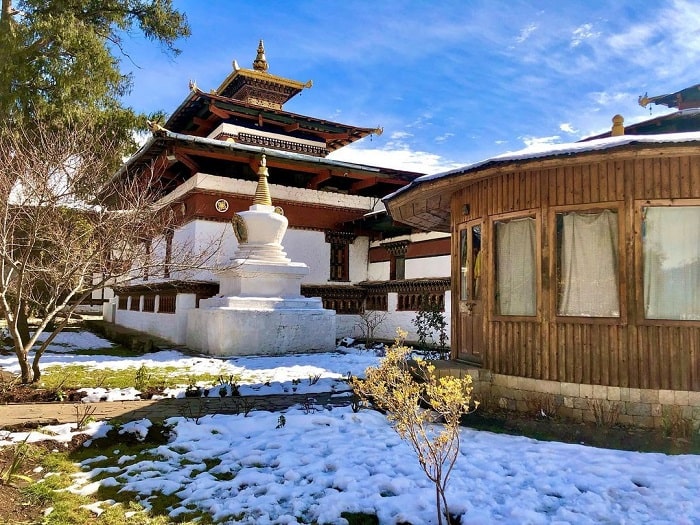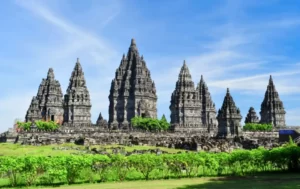Nestled amidst the majestic peaks of Himalayas, Bhutan, “Land of the Thunder Dragon” is a sanctuary of spirituality and serenity. For tourists seeking an odyssey unlike any other, this kingdom unveils its most treasured jewels: famous Buddhist temples.
Each temple, steeped in ancient lore and ensconced in nature’s embrace, tells tales of saints, warriors, and the divine. When you have the opportunity to visit the happiest country in the world, you will have the opportunity to learn more deeply about Bhutan’s cultural heritage, filled with mystery, art and centuries-old traditions.
1. Taktshang Goemba (Tiger’s Nest Monastery)
Taktshang Goemba, commonly referred to as the Tiger’s Nest Monastery, is an architectural and spiritual marvel nestled on the rugged cliffs of the Paro Valley in Bhutan. Suspended at an astounding altitude, the sight of this sacred monastery evokes feelings of wonder and reverence, making it one of the must-visit destinations in the Himalayan kingdom.
Taktshang Goemba are deeply rooted in legend. It is believed that in the 8th century, Guru Rinpoche, also known as Padmasambhava, introduced Buddhism to Bhutan and flew to this very site on the back of a tigress, hence its evocative name. Here, he meditated in the caves that the monastery now surrounds, forging a spiritual connection that has endured for centuries.
When you embark on your journey to this revered site, you are not merely setting out to visit a monastery but are partaking in a pilgrimage. The trek to Tiger’s Nest offers panoramic vistas of pristine Paro Valley, with its verdant terrains and undulating hills. The pathways, though moderately challenging, are adorned with prayer flags that flutter in the wind, carrying with them the blessings and prayers of the devout.
Upon reaching the monastery, you are greeted by an intricate tapestry of Bhutanese architecture and craftsmanship. The richly decorated courtyards, intricate woodwork, and stunning murals provide a glimpse into Bhutan’s deep-seated cultural and spiritual traditions. Delve deeper, and you can explore the sacred chambers and meditation caves that emanate an aura of peace and contemplation. Many of these rooms house statues and altars dedicated to deities, encapsulating the essence of Vajrayana Buddhism.
But beyond the architecture and religious artifacts, it’s the profound sense of serenity that engulfs you. Whether you’re a spiritual seeker or an avid traveler, the ambiance offers a unique opportunity for introspection and connection. As you soak in the panoramic views of the valley below, you can also partake in prayer sessions, lighting butter lamps as a gesture of reverence and hope.
2. Paro Rinpung Dzong
Paro Rinpung Dzong stands as a formidable and emblematic structure in the heart of the Paro Valley in Bhutan. With its towering walls and strategic location, the dzong, which translates to “fortress on a heap of jewels,” has served as a religious and administrative center for centuries, reflecting the deep interweave of governance and spirituality in Bhutanese culture.
Constructed in the 15th century, Paro Rinpung Dzong is a living testament to Bhutan’s architectural prowess and its adherence to traditional design principles. The massive buttressed walls that protect the complex from external threats conceal within them a labyrinth of courtyards, temples and administrative offices. The intricate woodwork, vibrant murals, and multi-tiered roofs, adorned with golden pinnacles, bear witness to a craftsmanship that has been passed down through generations.
When you step into this majestic edifice, you’re immediately enveloped in an ambiance that speaks volumes of Bhutan’s rich heritage. Central tower, or “utse,” is home to various sacred shrines and chapels. Here, you can witness ornate altars dedicated to prominent Buddhist deities, set against the backdrop of murals narrating tales from ancient scriptures. The mesmerizing hum of monks chanting and the aroma of incense further elevate the spiritual experience.
However, Paro Rinpung Dzong is not just a hub of religious activity. It plays a pivotal role during the annual Paro Tshechu, one of Bhutan’s most celebrated festivals. If you’re fortunate to visit during this time, you’ll be privy to a visual spectacle as the dzong’s courtyards come alive with traditional dances, vibrant costumes, and rituals that trace back centuries. This festival culminates in the unfurling of a giant thangka, an event that attracts both locals and international visitors in large numbers.
The dzong’s strategic location, overlooking the Paro Chu river, further enhances its allure. As you traverse its corridors and balconies, you’re treated to panoramic vistas of terraced fields, traditional Bhutanese homes, and the serenity of Paro Valley. This harmonious blend of nature and architecture makes it an irresistible attraction for photography enthusiasts and history buffs alike.
3. Punakha Dzong
Punakha Dzong, also known as “the palace of great happiness or bliss,” stands majestically at the confluence of two rivers, Pho Chhu (male river) and Mo Chhu (female river), in the Punakha valley of Bhutan. A masterpiece of Bhutanese architecture, this fortress-monastery is a synthesis of structural grandeur and cultural profundity, drawing travelers from around the world.
Historically, Punakha Dzong holds a position of paramount importance. Constructed in the 17th century, it served as the capital and the seat of the government of Bhutan until the mid-20th century. Its walls have witnessed numerous significant events, from the crowning of Bhutanese kings to landmark decisions shaping the destiny of the nation.
As you approach this colossal edifice, you’re met with a sight that is both imposing and awe-inspiring. The strategic location, combined with the fortress’s formidable walls and intricately carved wooden beams, embodies both defense and spirituality, reflecting the dual administrative and religious role of dzongs in Bhutan.
Once inside, the visual and sensory treat continues. You are greeted by a series of courtyards, halls, and living quarters, each bearing the hallmark of exquisite Bhutanese craftsmanship. The murals, paintings, and statues inside the dzong depict stories from Buddhist scriptures, offering insights into the spiritual ethos of the Bhutanese people.
A highlight of Punakha Dzong, and a must-visit for you, is the sacred relics it houses. Among them is the Ranjung Karsapani, a revered artifact believed to be an embodiment of the divine. The presence of these relics, along with the chants and meditations of the monks, creates an atmosphere that resonates with deep spirituality.
But beyond its architectural and religious allure, Punakha Dzong becomes a focal point of celebration during the annual Punakha Drubchen. If you align your visit with this festival, you’re in for an unforgettable experience. This festival commemorates the victory of Bhutan over Tibetan invaders, and you can witness a vivid display of historical re-enactments, traditional dances, and the local community’s vibrant participation.
Furthermore, the natural surroundings augment the dzong’s beauty. The rivers encircling the fortress, the blooming jacaranda trees during spring, and the backdrop of the Himalayas create picturesque vistas.
4. Tashichho Dzong
Tashichho Dzong, an emblematic structure situated on the northern edge of Thimphu, the capital city of Bhutan, seamlessly combines political and religious significance under its expansive roof. This architectural marvel, also known as the “fortress of the glorious religion,” serves as the administrative headquarters and the main monastic home in the capital, embodying the essence of Bhutan’s unique fusion of monastic and governmental roles.
The current form of Tashichho Dzong, with its grandeur and distinctive Bhutanese architecture, can be traced back to the mid-20th century, though its origins are much older. The whitewashed walls, punctuated by red and gold details, stand as silent testimonies to critical junctures in Bhutanese history, as the dzong has been renovated and reconstructed multiple times due to fires and earthquakes.
When you cross the threshold into this imposing fortress, you enter a realm where the past and present coalesce. The meticulously landscaped courtyards, extensive hallways, and intricate woodwork capture the attention of art and history aficionados. The impressive assembly hall and the central tower, housing sacred shrines and a monastery, offer you a window into the spiritual heart of Bhutan.
But Tashichho Dzong is more than a repository of historical and religious relics. As the seat of the government, it houses the throne room and offices of the King of Bhutan. The juxtaposition of monks in deep contemplation and government officials attending to state matters presents a captivating tableau of Bhutan’s societal structure. This dual function ensures that, as a visitor, you gain a comprehensive understanding of Bhutan’s socio-cultural milieu.
One of the best times for you to experience the vibrancy of Tashichho Dzong is during the Thimphu Tshechu, an annual festival marked by religious ceremonies, traditional dances, and colorful processions. The dzong’s courtyards come alive with performers and spectators, making it a melting pot of culture, spirituality and festivity.
The position of Tashichho Dzong, flanked by the Wang Chhu river and facing the Le Meridien Thimphu, further enhances its allure. As the evening sun casts a golden hue on its walls and the national flag is lowered in a solemn ceremony, you’re reminded of the dzong’s role as a sentinel of Bhutan’s traditions and governance.
5. Gangtey Goemba
Gangtey Goemba, nestled within the serene Phobjikha Valley, stands as a testament to Bhutan’s rich architectural and spiritual heritage. Also referred to as Gangtey Monastery, this 17th-century edifice is an essential center for the Nyingma school of Buddhism and serves as a beacon of spiritual solace and contemplative peace.
Perched atop a forested hill, Gangtey Goemba provides a panoramic view of the expansive Phobjikha Valley below. Monastery complex itself is a marvel of traditional Bhutanese architecture. The intricate woodwork, vibrant frescoes, and ornate carvings reflect a deep reverence for both artistry and spirituality. The central goenkhang, or the sanctuary, is a repository of ancient scriptures and images, shedding light on the rich tapestry of Vajrayana Buddhism.
When you embark on a visit to Gangtey Goemba, you’re not merely entering a building; you’re stepping into an oasis of spiritual rejuvenation. The ambient chants, the aroma of incense, and the devout monks in meditative repose invite you to pause and reflect. The monastery’s tranquil setting further accentuates its spiritual ambiance, allowing you to momentarily escape the trappings of modern life and commune with your inner self.
Beyond its spiritual offerings, Gangtey Goemba is integrally linked to the annual Black-Necked Crane Festival. The Phobjikha Valley, on which the monastery overlooks, is a winter haven for the endangered black-necked cranes. Their annual migration from the Tibetan plateau to this valley is celebrated at the monastery with dances, songs, and plays. Should you time your visit with this festival, you’ll be treated to a vibrant blend of culture, nature and spirituality.
Moreover, the surrounding valley offers myriad experiences for the discerning traveler. Nature walks, treks, and bird-watching opportunities abound. The sight of the graceful black-necked cranes dancing in the valley, especially with the monastery as a backdrop, is a vision that remains etched in memory. For those inclined towards deeper cultural immersion, interacting with the local communities provides insights into their traditions, rituals and daily life.
Whether you seek solace, cultural immersion, or simply the charm of Himalayan landscape, the monastery promises an experience that transcends the ordinary. As you leave its precincts, you carry with you not just memories but also a deeper appreciation for Bhutan’s spiritual and natural wealth.
6. Kurjey Lhakhang
Kurjey Lhakhang, located in the Bumthang Valley of Bhutan, holds a revered position in the spiritual and historical landscape of the kingdom. Its name, when translated, means “Body Imprint Temple,” and this monastic complex bears an intimate connection to Guru Rinpoche, also known as Padmasambhava, a pivotal figure in the spread of Vajrayana Buddhism in the Himalayas.
The legend surrounding Kurjey Lhakhang speaks of Guru Rinpoche’s battle against a local deity who opposed the spread of Buddhism. Subduing the deity, Guru Rinpoche left his body imprint on a cave within which the temple now stands, thus giving the monastery its evocative name. This intimate connection with the revered Guru makes the temple a focal point of devotion and pilgrimage.
When you venture into Kurjey Lhakhang, you’re stepping onto grounds imbued with profound spirituality. The temple complex consists of three main buildings, with the oldest dating back to the 17th century. Each of these structures houses statues, paintings, and artifacts, offering insights into Bhutan’s rich Buddhist heritage. The cave, with Guru Rinpoche’s imprint, remains the centerpiece of the complex, and many visitors describe a palpable aura of spirituality enveloping it.
Your journey through the temple complex also acquaints you with Bhutan’s architectural prowess. The traditional design, coupled with intricate woodwork, colorful murals, and the distinctive tiered roofs, encapsulates Bhutanese aesthetics and reverence. The prayer wheels, fluttering prayer flags, and the serene background chants further augment the ambiance, inviting introspection and reverence.
But Kurjey Lhakhang’s appeal extends beyond its historical and spiritual dimensions. Its location amidst tall cypress trees and with a backdrop of soaring mountains lends a natural tranquility that complements its spiritual essence. The Chokhor Mani Nang, a large chorten wall, stands nearby and is a significant architectural addition that you shouldn’t miss.
The annual tsechu, a religious festival, further animates Kurjey Lhakhang. If your visit aligns with this event, you witness a mosaic of colors, dances, and rituals, all commemorating Guru Rinpoche’s deeds and teachings. The community’s involvement, the elaborate masks, and the traditional music make the festival a memorable experience.
Kurjey Lhakhang offers you a holistic experience, blending the spiritual, historical, architectural, and natural. Your encounter with this temple promises to be both enlightening and enriching, making it a must-visit destination in Bhutan’s spiritual heartland.
7. Kyichu Lhakhang
Kyichu Lhakhang, ensconced in the verdant Paro Valley, stands as one of Bhutan’s oldest and most venerated temples. With origins tracing back to the 7th century, this religious edifice is among the two temples that were constructed to subdue a demoness terrorizing the Himalayan region, thus paving the way for the proliferation of Buddhism in Bhutan.
The history of Kyichu Lhakhang is intertwined with the legend of Tibetan King Songtsen Gampo. As part of his mission to spread Buddhism, the king is believed to have constructed 108 temples in a single day, with Kyichu Lhakhang being a pivotal one. Given its foundational significance to Bhutanese Buddhism, the temple has been revered as a spiritual anchor for the nation.
As you traverse the thresholds of Kyichu Lhakhang, the weight of centuries becomes palpable. The main sanctum of the temple houses a revered statue of Jowo Sakyamuni, believed to be the original statue brought during the temple’s inception. The surrounding walls are adorned with intricate frescoes and murals that chronicle the life of Buddha, offering a visual journey through the tenets of Buddhism.
The architectural facets of Kyichu Lhakhang offer a study in traditional Bhutanese aesthetics. From its whitewashed walls and dark wooden beams to the gilded roof and ornate details, the temple captures the essence of Himalayan religious architecture. Amidst the temple’s serene ambiance, the fragrance of incense wafts, and the gentle hum of monks chanting reverberates, creating an aura of peace and contemplation.
Your exploration of Kyichu Lhakhang is not limited to its interiors. The temple complex also boasts an enchanting garden, dotted with prayer wheels and punctuated by a large, ornate chorten. Turning these prayer wheels, as per local beliefs, can multiply your merits and promote inner harmony.
Kyichu Lhakhang’s appeal extends beyond its spiritual and historical dimensions. Situated against a backdrop of snow-clad mountains and surrounded by lush vegetation, temple offers a visual feast. The juxtaposition of the age-old structure with the natural beauty of Paro Valley accentuates its allure, making it a photographer’s delight.
Seasonal religious festivals further elevate Kyichu Lhakhang’s charm. If you find yourself visiting during these occasions, you’ll be privy to a spectrum of traditional dances, rituals, and prayers that encapsulate Bhutanese spiritual and cultural richness. With its multi-faceted offerings, it stands not just as a monument of the past, but as a living testament to Bhutan’s unwavering devotion to Buddhism.
8. Jambay Lhakhang
Jambay Lhakhang, gracefully positioned in Bhutan’s spiritual heartland of Bumthang, is a seminal icon in the tapestry of Himalayan Buddhism. Renowned as one of the 108 temples constructed by Tibetan King Songtsen Gampo in the 7th century, it carries a spiritual gravitas that draws pilgrims and travelers alike from the world over.
Legend has it that King Songtsen Gampo embarked on a mission to construct 108 temples across the Himalayas to pin down an ogress obstructing the spread of Buddhism. Jambay Lhakhang was pivotal in this mission, and its very foundation is believed to have subdued the demoness’s left knee. As you wander through its historic precincts, you can almost feel the reverberations of these ancient narratives, making it a veritable journey through time.
Upon entering Jambay Lhakhang, you are greeted by the exquisite architecture that exemplifies Bhutanese craftsmanship. Its rich wooden columns, elaborately designed frescoes, and the intricate mandalas echo tales of yore, devotion and artistic prowess. The central shrine, housing the statue of Jowo Jampa (Maitreya), emanates a profound serenity, offering a sanctuary for contemplation.
However, what truly amplifies Jambay Lhakhang’s allure is its vibrant annual festival, the Jambay Lhakhang Drup. If your sojourn aligns with this event, you are in for an unparalleled cultural extravaganza. One of the highlights of this festival is the ‘Mewang’ – the Fire Ritual, where you can witness locals leaping over bonfires in a ceremonial purification rite. Another spectacle is the ‘Tercham’ or Naked Dance, performed in the cover of the night, believed to bless infertile women and bestow them with children.
Beyond the temple’s spiritual and cultural offerings, its location in the verdant Bumthang valley amplifies its appeal. The harmony of the age-old structure with the undulating landscape and the azure skies presents a picturesque tableau, providing ample opportunities for photography enthusiasts.
Furthermore, your experience at Jambay Lhakhang can be complemented by interactions with the local monks and devotees. Their stories, rituals, and daily practices provide invaluable insights into the nuances of Bhutanese spirituality and way of life.
9. Drukgyel Dzong
Drukgyel Dzong, perched majestically in the upper reaches of the Paro Valley, is a symbol of Bhutan’s triumphant resistance against foreign invasions. Translated as “Fortress of the Victorious Drukpa,” this historic fortress-monastery stands as a testament to the strategic acumen and architectural prowess of the Bhutanese in the 17th century.
Established in 1649 by Zhabdrung Ngawang Namgyal, the unifier of Bhutan, Drukgyel Dzong served a dual purpose. While it was a center of Buddhist learning and spirituality, it was primarily constructed to commemorate and defend against Tibetan invasions. It is said that from the vantage points of this dzong, the Bhutanese repelled several invasions, notably in 1644, thus solidifying its reputation as an indomitable bastion.
As you approach Drukgyel Dzong, its imposing walls and strategic positioning offer a glimpse into its historic military significance. Though a fire in 1951 rendered parts of it in ruins, recent restoration efforts have revived much of its former grandeur. The remnants of the dzong, juxtaposed against the backdrop of the snow-clad Mount Jomolhari, create a visual spectacle, embodying Bhutan’s blend of natural beauty and architectural heritage.
Navigating through Drukgyel Dzong allows you to delve deep into Bhutan’s history. Each corridor, watchtower, and courtyard tells a tale of strategic brilliance, valiant defenders, and the overarching importance of preserving national integrity. The dzong’s design, from its thick walls to its sloping roofs, showcases traditional Bhutanese architecture, tailored to both the region’s climate and its defensive needs.
While the historical and architectural aspects of Drukgyel Dzong captivate many, its setting amidst verdant rice fields and traditional Bhutanese villages further enhances its appeal. This pastoral setting provides an opportunity for you to immerse yourself in local culture, interact with villagers, and perhaps even partake in daily agricultural activities.
The annual Tsechu festival, a significant event in the Bhutanese calendar, sees Drukgyel Dzong and its surroundings come alive with color, dance, and religious rituals. If your visit coincides with this event, you’re offered a front-row seat to the rich tapestry of Bhutanese culture, tradition and spirituality.
Drukgyel Dzong, with its historical gravitas, architectural allure, and cultural richness, offers a multifaceted experience. As you traverse its grounds, you not only journey through Bhutan’s storied past but also engage with its living traditions and natural splendor. It serves as a poignant reminder of Bhutan’s resilience and an invitation to explore the deeper facets of this Himalayan kingdom.
10. Chimi Lhakhang
Chimi Lhakhang, nestled in the heart of the Punakha Valley, is more than just a temple; it is an embodiment of Bhutan’s unique blend of spiritualism, culture, and humor. Commonly referred to as the “Fertility Temple,” this sacred site is dedicated to Lama Drukpa Kunley, colloquially known as the “Divine Madman” for his unconventional and often eccentric methods of teaching Buddhism.
Narrative of Chimi Lhakhang is intrinsically tied to Lama Drukpa Kunley, a 15th-century Buddhist monk whose teachings often shattered orthodox norms. His audacious approach to spiritual enlightenment, combined with his penchant for humor and song, endeared him to the masses and established him as a legendary figure in Bhutanese folklore. The temple itself was constructed in his honor by his cousin, Ngawang Choegyel, after the Lama subdued a demon at this very location, turning it into a protective deity.
Upon your arrival at Chimi Lhakhang, a short, picturesque walk through vibrant rice fields and quaint hamlets sets the tone for your visit. The path, dotted with colorful prayer flags fluttering in the wind, guides you to the temple, with the lush Punakha landscape sprawling out in every direction.
The temple’s architecture, with its golden spires and red and gold pillars, stands as a beacon of traditional Bhutanese craftsmanship. As you step inside, you’re immediately enveloped in an aura of reverence and mysticism. The walls, adorned with murals depicting the life and teachings of Lama Drukpa Kunley, offer a visual narrative of his legendary exploits. Particularly intriguing for many visitors is the ubiquitous phallic imagery, a symbol associated with the Lama, representing both fertility and the power to ward off evil.
Yet, it’s the temple’s reputation as a beacon of fertility that has garnered global attention. Couples from across Bhutan and even internationally, seeking blessings for progeny, make pilgrimages to Chimi Lhakhang. Participating in the temple’s unique rituals, often presided over by the resident monks, is believed to bestow blessings of fertility upon the aspirants.
Furthermore, the local marketplace adjacent to the temple provides you with an opportunity to immerse yourself in Bhutanese culture. From handcrafted souvenirs and religious artifacts to the playful yet respectful phallic-themed crafts, there’s a myriad of items reflecting the region’s deep-rooted traditions.
Bhutan, often called ‘Last Shangri-La’, attracts tourists with its harmonious blend of pristine nature and spiritual sanctity. The most famous Buddhist temples in this Himalayan kingdom are more than just places of worship; They are wonderful experiences that await discerning travelers like you.















